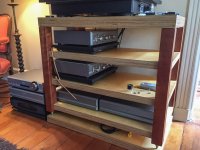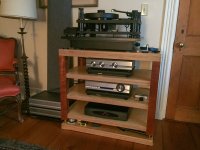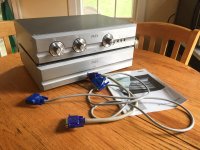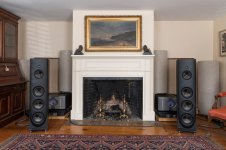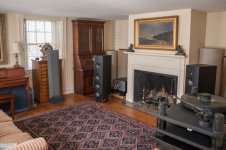You are using an out of date browser. It may not display this or other websites correctly.
You should upgrade or use an alternative browser.
You should upgrade or use an alternative browser.
Pass Labs XP27 phono stage
- Thread starter PeterA
- Start date
- Thread Author
- #2
I guess I can now answer my own question.
I recently directly compared my Pass Labs XP-25 phono stage to its replacement, the XP-27. I had the XP-27 in for a ten day trial audition period. About a year ago, I replaced my XP-20 preamp with the new XP-22. I rearranged my rack, as I had before for the preamp comparison, to facilitate easy cable swapping for blind listening evaluations. Previously, I have owned the Pass Ono, the XOno, and the XP-25 phono stages.
I let XP-27 warm up for a couple of days before doing any serious listening,. I use Transparent Audio REF XL balanced cables, and in this case I was switching a 1.0 M length between the two phono stages and the XP-22 preamp. I left both phono stages powered on for the entire ten day testing period.
The output impedances varies slightly between the XP-25 (250 ohms) and the XP-27 (220 ohms), so both my dealer and I thought that I could use the same calibrated cable for the testing. Transparent Audio told me that I would get slightly better results with a recalibrated cable for the 27. They told me that the tone would be slightly effected by cable if used with the 27. The build quality and casework between the two units seems identical. The only visual difference is that the front vertical edges on the faceplate are chamfered on the 25 and cut straight on the 27. You can read about the technical differences and what Pass did to change the sound of the 27 on their website: https://www.passlabs.com/preamplifier/xp-27
During the initial break in period of the first few days, the two units sounded fairly similar. I noticed a slightly more extended bass with the 27 and thought it might have sounded a little more dynamic, but otherwise the differences were pretty minor. Then on about day five, my good friend and audio buddy, Al M. came over to hear the new phono stage and compare it to the old one. He is an experienced listener and, like I do, he uses live acoustic music as his reference. He is very familiar with my system so I looked forward to learning his listening impressions of the 27 and how he thought it differed from the 25.
I conducted a series of blind A/B/A… tests with some familiar music. Here are the notes from that listening session:
Round 1: Transparent cable, calibrated for the XP-25
1. Sonny Rollins, Way Out West, A/B
2. Janaki Trio, B/A/B
3. Holst Male Choral, B/A
4. Holst Female Choral, A/B/A
5. Holst Planets, Jupiter, A/B
6.. Bach Partita no. 1, B/A
Round 2: Burley Wire, no cable bias
1. Bach Partita no. 1, A/B
2. Holst Planets, Uranus, B/A
3. Holst Female Choral, A/B
4. Holst Male Choral, B/A
5. Bach Partita no.2 B/A
A = XP27, new phono
B = XP25, old phono
Peter was switching cables between phono stages while Al left the room. Al was in sweet spot and listened “blind”. In Round 1, Al consistently preferred “B”. Peter, sat in the right seat and listened “sighted” and consistently preferred “A”. We took a break for tea and cake and discussed results. The disagreement was interesting and we were both confused about why the other had a different preference.
In round 2 we switched to a cable from Pass Labs called Burley Wire so that the Transparent cable which was calibrated for the XP25 would not bias our listening. With the Burley wire, Al preferred the XP25 for the first selection and then the XP27 for the rest, #’s 2-5. Peter still preferred the XP27 for all five selections.
In the end, it is clear that the new XP27 is better. It is cleaner sounding. The bass is deeper, more articulate, more impactful, less “fat”. I think that the XP25 has a slightly “fuzzy” sound, a bit more diffuse. The clarity with the XP27 is startling. I think this is because of lower noise, and lower distortion. The singers were more distinct and separate and clear with the XP27. Leading edge transient information was finer, detailed, and clean with the XP27. The Transparent cable helped the XP25 in Round 1. With that advantage gone, we both preferred the XP27. It seems that the Transparent cable, not properly calibrated for the XP27, slightly affected various frequencies and changed the tonal character slightly. With the Burley Wire, the tone and timbral accuracy of the XP-27 improved. Here is a summation:
XP27:
1. Lower noise
2. Lower distortion
3. Deeper bass, more articulate bass, less fat, more impact/punch
4. Better transient attack, fine, more precise leading edge
5. Cleaner, clearer sound, more resolution
6. Deeper stage, better hall information
7. Slightly more dynamic, explosive
After dinner, I played the Sheffield Drum Track. Wow. It was explosive and loud with very little distortion. There was incredible nuance between the different types of drums and it had huge impact and dynamics. The different drum characteristics and his technique has never been more discernible.
I am still listening with the Burley Wire IC because it sounds so good, but I plan to send my Transparent Audio cable back for recalibration to see if it will sound even better. The XP-27 has continued to improve over time. It seems that the complete break in period was about ten days. I have now had it in my system for sixteen days, powered on the whole time.
Since Al heard it on the fifth day, the resolution has continued to improve. Low level information is even more clear. Micro and macro dynamics are better. The soundstage is about the same, but the depth has increased. Presence, an attribute of my system about which I am very pleased, is even more pronounced. I have not heard this level of 3-D palpability before. Timbral accuracy has never sounded more real in my system. The overall impression is one of improved clarity and a more natural sound. Everything just sounds more real to me. I returned the XP-25 and received a trade-in allowance.
This new generation of Pass electronics is a clear improvement over the previous generation. I am told that there is some trickle down technology from the Pass flagship XS line. I could not be happier with the upgrade. It is by far the best Pass phono stage that I have owned and heard in my system. I actually think that the improvement over the XP-25 is greater than the improvement of the XP-22 over the XP-20. It is really a remarkable sounding phono stage.
The XP-27 arrives:

The direct comparison between the XP-25 (top shelf) and the XP-27 (middle shelf) with both power supplies on bottom shelf:

The final configuration post testing with XP-27 on top shelf, XP-22 on middle shelf with power supplies off to the side.

The old XP-25 ready for boxing and shipping for trade-in:

I recently directly compared my Pass Labs XP-25 phono stage to its replacement, the XP-27. I had the XP-27 in for a ten day trial audition period. About a year ago, I replaced my XP-20 preamp with the new XP-22. I rearranged my rack, as I had before for the preamp comparison, to facilitate easy cable swapping for blind listening evaluations. Previously, I have owned the Pass Ono, the XOno, and the XP-25 phono stages.
I let XP-27 warm up for a couple of days before doing any serious listening,. I use Transparent Audio REF XL balanced cables, and in this case I was switching a 1.0 M length between the two phono stages and the XP-22 preamp. I left both phono stages powered on for the entire ten day testing period.
The output impedances varies slightly between the XP-25 (250 ohms) and the XP-27 (220 ohms), so both my dealer and I thought that I could use the same calibrated cable for the testing. Transparent Audio told me that I would get slightly better results with a recalibrated cable for the 27. They told me that the tone would be slightly effected by cable if used with the 27. The build quality and casework between the two units seems identical. The only visual difference is that the front vertical edges on the faceplate are chamfered on the 25 and cut straight on the 27. You can read about the technical differences and what Pass did to change the sound of the 27 on their website: https://www.passlabs.com/preamplifier/xp-27
During the initial break in period of the first few days, the two units sounded fairly similar. I noticed a slightly more extended bass with the 27 and thought it might have sounded a little more dynamic, but otherwise the differences were pretty minor. Then on about day five, my good friend and audio buddy, Al M. came over to hear the new phono stage and compare it to the old one. He is an experienced listener and, like I do, he uses live acoustic music as his reference. He is very familiar with my system so I looked forward to learning his listening impressions of the 27 and how he thought it differed from the 25.
I conducted a series of blind A/B/A… tests with some familiar music. Here are the notes from that listening session:
Round 1: Transparent cable, calibrated for the XP-25
1. Sonny Rollins, Way Out West, A/B
2. Janaki Trio, B/A/B
3. Holst Male Choral, B/A
4. Holst Female Choral, A/B/A
5. Holst Planets, Jupiter, A/B
6.. Bach Partita no. 1, B/A
Round 2: Burley Wire, no cable bias
1. Bach Partita no. 1, A/B
2. Holst Planets, Uranus, B/A
3. Holst Female Choral, A/B
4. Holst Male Choral, B/A
5. Bach Partita no.2 B/A
A = XP27, new phono
B = XP25, old phono
Peter was switching cables between phono stages while Al left the room. Al was in sweet spot and listened “blind”. In Round 1, Al consistently preferred “B”. Peter, sat in the right seat and listened “sighted” and consistently preferred “A”. We took a break for tea and cake and discussed results. The disagreement was interesting and we were both confused about why the other had a different preference.
In round 2 we switched to a cable from Pass Labs called Burley Wire so that the Transparent cable which was calibrated for the XP25 would not bias our listening. With the Burley wire, Al preferred the XP25 for the first selection and then the XP27 for the rest, #’s 2-5. Peter still preferred the XP27 for all five selections.
In the end, it is clear that the new XP27 is better. It is cleaner sounding. The bass is deeper, more articulate, more impactful, less “fat”. I think that the XP25 has a slightly “fuzzy” sound, a bit more diffuse. The clarity with the XP27 is startling. I think this is because of lower noise, and lower distortion. The singers were more distinct and separate and clear with the XP27. Leading edge transient information was finer, detailed, and clean with the XP27. The Transparent cable helped the XP25 in Round 1. With that advantage gone, we both preferred the XP27. It seems that the Transparent cable, not properly calibrated for the XP27, slightly affected various frequencies and changed the tonal character slightly. With the Burley Wire, the tone and timbral accuracy of the XP-27 improved. Here is a summation:
XP27:
1. Lower noise
2. Lower distortion
3. Deeper bass, more articulate bass, less fat, more impact/punch
4. Better transient attack, fine, more precise leading edge
5. Cleaner, clearer sound, more resolution
6. Deeper stage, better hall information
7. Slightly more dynamic, explosive
After dinner, I played the Sheffield Drum Track. Wow. It was explosive and loud with very little distortion. There was incredible nuance between the different types of drums and it had huge impact and dynamics. The different drum characteristics and his technique has never been more discernible.
I am still listening with the Burley Wire IC because it sounds so good, but I plan to send my Transparent Audio cable back for recalibration to see if it will sound even better. The XP-27 has continued to improve over time. It seems that the complete break in period was about ten days. I have now had it in my system for sixteen days, powered on the whole time.
Since Al heard it on the fifth day, the resolution has continued to improve. Low level information is even more clear. Micro and macro dynamics are better. The soundstage is about the same, but the depth has increased. Presence, an attribute of my system about which I am very pleased, is even more pronounced. I have not heard this level of 3-D palpability before. Timbral accuracy has never sounded more real in my system. The overall impression is one of improved clarity and a more natural sound. Everything just sounds more real to me. I returned the XP-25 and received a trade-in allowance.
This new generation of Pass electronics is a clear improvement over the previous generation. I am told that there is some trickle down technology from the Pass flagship XS line. I could not be happier with the upgrade. It is by far the best Pass phono stage that I have owned and heard in my system. I actually think that the improvement over the XP-25 is greater than the improvement of the XP-22 over the XP-20. It is really a remarkable sounding phono stage.
The XP-27 arrives:
The direct comparison between the XP-25 (top shelf) and the XP-27 (middle shelf) with both power supplies on bottom shelf:
The final configuration post testing with XP-27 on top shelf, XP-22 on middle shelf with power supplies off to the side.
The old XP-25 ready for boxing and shipping for trade-in:
Attachments
GSOphile
Active member
Peter, that's a truly impressive comparison. The audio press could learn from you guys.


